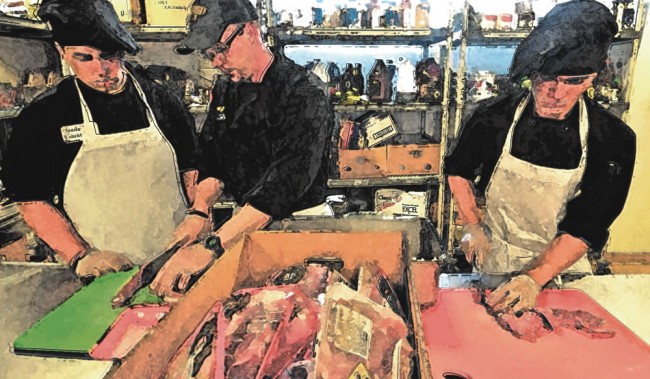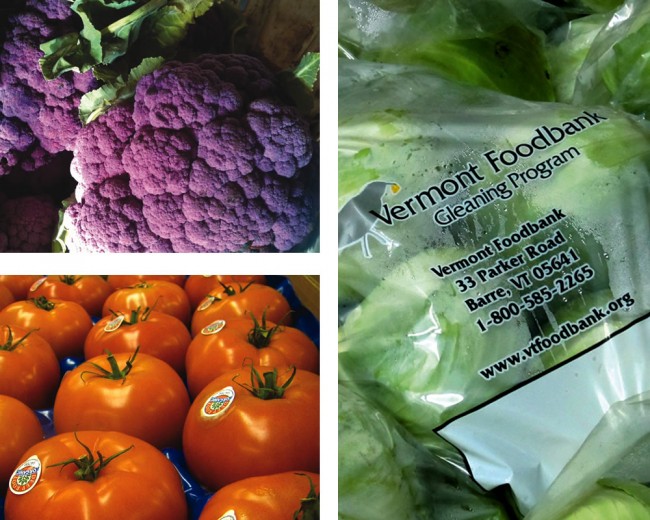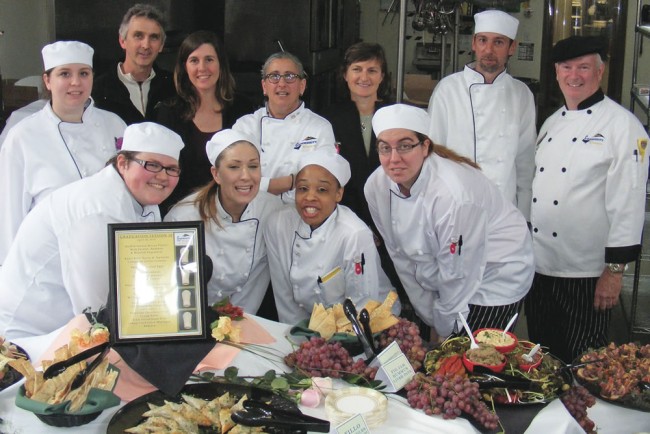Vermont Foodbank program utilizes highly perishable donated food products as learning tools for students enrolled in its Community Kitchen Academy to make meals distributed via food assistance programs.
Nate Clark
BioCycle May 2013, Vol. 54, No. 5, p. 18

The Community Kitchen Academy utilizes donated food products such as meat that are highly perishable and would otherwise be wasted. Culinary training includes trimming and knife skills.
The Vermont Foodbank, a supported affiliate of Feeding America, has been successful at aiding as many as 86,000 Vermont residents with food assistance through its programs and networks in the state. Like many similar organizations, the Vermont Foodbank encountered problems when it came to donations of meats, dairy, produce or any other food product with a fast-approaching expiration date. But instead of deciding to not accept these items, staff at the Vermont Foodbank had a different thought. “We had the idea of developing a community kitchen program to recapture food that would be wasted to make meals to feed hungry people,” explains Michelle Wallace, Vermont Foodbank’s Program Director of the Community Kitchen Academy. The program is designed to utilize donated food products that are highly perishable and would otherwise be wasted as learning tools for students enrolled in the culinary job training program to make meals distributed via food assistance programs.
Academic Program
The Vermont Foodbank’s Community Kitchen Academy (CKA) began in Burlington, Vermont in 2009 in partnership with the Chittenden Emergency Food Shelf, the largest food shelf/pantry in Vermont. The program is intended to target individuals from vulnerable populations, many who are unemployed or underemployed and lacking employment advancement opportunities, and provide students with food safety and preparation skills, as well as training in professional activities like resume writing and interviewing. Each academic session is 13 weeks, with time split between the classroom and the kitchen. Meals prepared by students are either served immediately at the Food Shelf’s hot meal program, or vacuum-sealed and frozen for families to take home. Students graduate from the program “ServSafe” certified, a nationally acknowledged food industry standard for food safety. Kim Prendergast, a consulting project manager with Feeding America who works with community kitchens established by Feeding America member food banks, notes that this is particularly valuable for the students in their job search because food service establishments are required to have ServSafe-certified individuals on staff. “ServSafe is administered by the National Restaurant Association’s Educational Foundation, which provides discounts for the materials to programs like CKA,” she says.
In 2012, CKA received accreditation from the Vermont State Colleges Office of External Programs. Students who graduate may also receive nine college-level academic transfer credits. Of the roughly 30 culinary training programs in the Feeding America network, only CKA and another program in Cincinnati, Ohio have college credits available to graduates, notes Prendergast. “It is a wonderful additional service. Many students want to go on to get Associates Degrees. The CKA training is available at no cost, so it is a great jumpstart for students pursuing further education.”
Integrating a culinary job training program into a food rescue organization’s services was pioneered by the DC Central Kitchen in Washington, DC, note both Wallace and Prendergast. The DC Central Kitchen prepares 5,000 meals a day, and uses as much locally sourced food as possible. It purchases the food it prepares, which is required to be eligible for a USDA reimbursement to organizations providing meals to low-income children. “The USDA program has a lot of requirements for nutritional quality, which necessitates having to purchase food versus relying on donations,” explains Prendergast. “Revenue from sale of the meals plus the reimbursements support the overall programs.” The CKA utilizes over 95 percent donated food, adds Wallace. “We adhere to very good nutritional standards but our meals are not subject to verification by a nutritionist. Using donated product gives us a huge amount of flexibility. We basically create our menu using what comes in that day.”
Food Sourcing And Preparation
Located at the Chittenden Emergency Food Shelf in Burlington, CKA rescues food items that cannot safely be stored and redistributed. “The Academy can be really helpful when, for example, 50 pound boxes of chicken are donated, because these items are hard to distribute directly to families through a food shelf,” notes Wallace. “It provides flexibility by separating food for meal production, and for simple processing and repackaging.” The CKA also makes the turnaround for highly perishable food much faster. Students are in the kitchen preparing meals every day with the ingredients available, and thus items like dairy or produce can be quickly incorporated. Because typical meals provided through food assistance programs tend to lack protein, dairy and vegetables due to the abbreviated shelf life of these items, CKA has become an essential service.

The CKA uses produce donated from grocery stores and other outlets, as well as from Vermont Foodbank’s gleaning program that works with farms in Vermont to harvest excess or unmarketable produce.
Reciprocal relationships exist between food donors and employers of graduates from the CKA program. “Representatives from the food service industry and restaurants become partners in many different ways — as employers, donors, supporters of the program, even speakers at graduation,” says Wallace. “It is a very positive experience for everyone. This is also important because a great fit for many graduates of the program are institutions like hospitals and universities. For a single parent, one of the best possible places for employment may be a school or health-care facility where the schedule can accommodate the needs of working families.”

Since 2009, twelve 13-week sessions have been conducted at the Community Kitchen Academy, graduating 87 students with an 86 percent success rate in job placement or continuing education.
The Vermont Foodbank plans to open a second Community Kitchen Academy in Barre, Vermont, in partnership with the Central Vermont Community Action Council in July 2013. Wallace says that organizations that deal with poverty in Barre are expressing lots of interest and excitement in the idea, giving her confidence that the program will be well received in that community as well.
The benefits of community culinary training programs touch on all three pillars of sustainability: Social, Economic, and Environmental. By offering an educational and training service to a vulnerable population, as well as providing meals to those in need, Community Kitchen Academy achieves social goals. According to Vermont state officials, the hospitality and food service industry has been identified as “in need of trained employees.” Academy graduates are exactly that, thus achieving an economic goal for the state. But in general, increasing the employability of unemployed and underemployed individuals provides obvious economic benefits. And as for environmental, reusing food products that would otherwise be disposed of is a necessary step in complying with Vermont’s new “universal recycling” legislation passed in July 2012.
Nate Clark is a Contributing Editor to BioCycle. He recently earned a Bachelor of Science in Environmental Studies from the Rubenstein School for the Environment and Natural Resources at the University of Vermont.










